|
INTRO
There are a few of us modelers that have a great fascination for artillery
pieces. Like in the days before Dragon, Revell and the world of short
run & cast resin vehicle kits, we’ve learned to continue
to scratchbuild and convert freely when we want something. Two relatively
easy conversions are described in Ian Hogg’s excellent book
GERMAN ARTILLERY of World War Two: the rare 7M85 and 7M59 field guns.
A SHORT HISTORY
Both guns were late WW2 attempts by the Germans to produce a dual
field gun [Feld Kanone or FK for short] with acceptable anti-tank
capability. This seems along the lines of the Soviet 76.2-mm ZiS 3
and M1936 field guns. Both guns were marginally acceptable but too
late and too few to have any real effect or to see much service. Ian
Hogg’s book explains that the unusual nomenclature [7M85 and
7M59] is derived from a late war system. The first number “7”
denotes the caliber group of the weapon: 7.5-cm. The letter “M”
signifies the ammunition group. The final number “85”
and “59” were the final digits of the weapon’s drawing
number.
DESCRIPTIONS
The 7M85 was a retrograde amalgamation of the cradle, shield and carriage
from the leFH 18/40 field howitzer with the gun and recoil system
of the Pak 40 anti tank gun. It was retrograde in that the carriage
of the le FH 18/40 was originally derived from the Pak 40 gun. Sturmvogel
website states that 10 of these were produced in 1944. The weapon
had an elevation of up to 42 degrees, 20 degrees greater than the
Pak 40 and had a maximum range of 10275 meters, compared to 7680-meters
for the Pak 40. According to Hogg, the length of the gun bore was
2471-mm, which is 730-mm shorter than the Pak 40’s bore length
of 3201-mm. I believe that this difference does not reflect the actual
difference in length of the barrel though. Fellow modeler Robert Moore
recently wrote me that the Rheinmetall company informed him that the
7M85’s barrel was indeed shorter than the Pak 40’s. One
reference I did find states that the 7M85 had a barrel length of 43
calibers [L43], compared to the Pak 40 L46. This length makes sense
to me as it matches the barrel length of the initial KwK 40 gun issued
on the PzKpfw IV and StuG IIIF. Based on this, I removed 3-mm from
the length of the Roden 1/72 scale kit’s barrel.
The cartridge length for the 7M85 was 690-mm, 2.5 cm shorter than
the Pak 40’s cartridge, which is 0.3-mm shorter in 1/72 scale;
hardly noticeable. Wide scale issue of this gun and its ammunition
this could have made German ammunition supply logistics even worse
than it was!
The 7M59 was another attempt at a dual purpose field gun [Feldkanone]
and antitank [Panzerabwehrkanone] weapon but much more simple than
the 7M85. The carriage and shield of the Pak 40 were modified to give
a greater elevation of 35 degrees for a maximum range of 13300-meters.
Sturmvogel website states that 10 were produced in 1945.
BASE KITS TO USE FOR THE CONVERSIONS
What we need to construct a FK 7M85 in 1/72 scale:
a. The Pak 40 gun & recoil system from Roden, ESCI, Dragon or
AlBy. The Fujimi Pak 40 gun will also work in 1/76 scale.
b. The carriage and trails from the Roden, ESCI or AlBy Pak 40 kits;
or carriage and trails from the LEVA or ACE le FH 18/40 kits.
c. Gun shield and wheels from the LEVA or the ACE le FH 18/40 model.
The leFH 18/40 and 7M85 have wheels smaller than the le FH 18 and
larger than the Pak 40’s.
d. A dial sight is needed, taken from the ACE or Revell le FH 18 kits.
If you wish to model the weapon being towed then dispense with the
sight as it would be stored during transport.
e. A small storage box should be added to the left trail just aft
of the vertical grab handle.
f. The overhanging hood over the gun on the back of the le FH 18 shield
needs to be removed and replaced by a sliding vertical shield similar
to that on the Pak 40 and Pak 38.
What we need to produce an FK 7M59:
a. This a more straightforward conversion using only a change on the
gun shield so the gun can elevate higher, addition of a tow hitch
to the lower shield, and modification of the gunner’s recoil
guard. All photos of museum specimen show the characteristics matching
the gun’s description in Ian Hogg’s book.
b. Carefully cut the shield’s opening for the gun, vertically
splitting the shield in two halves. Using the reference add extended
pieces and a new sliding part that covers the hole when the gun is
lowered & raised. The real piece is attached with rivets to the
larger shield, hard to model in 1/72.
c. The gunner’s recoil guard is a normally a sheet metal and
tube frame designed to protect the gunner from being struck by the
violently recoiling breech block. My reference shows it to be a much
smaller metal bar [more appropriate for a field gun?].
d. The traverse and elevation handwheels are the same as on the original
Pak 40, both on the left side below the gunsight.
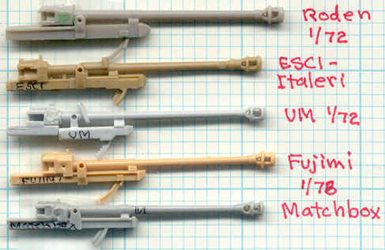
e. Above is a scan comparing the gun & recoil mechanisms of the
1/72 scale Roden, and ESCI/Italeri Pak 40 kits, as well as those from
a UM Marder kit and the 1/76 scale Fujimi and Matchbox Pak 40 parts.
Notice that Roden, Fujimi and ESCI have sink holes in the breech block.
Roden breaks their gun, and other parts, down into many more steps
such as a separate recoil system and gun barrel, allowing us more
flexibility in assembling the model though it is still missing some
detail. ESCI has molded their Pak 40 in half recoil, something hard
to fix and very annoying to me. I am not pleased with UM’s gun
which seems too small and a poorly rendered recoil system under the
gun. Fujimi’s Pak 40 gun looks very nice.
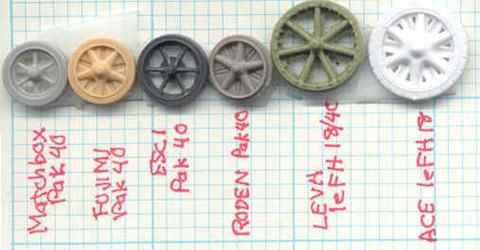
f. For the FK 7M85 gun we have a choice
of using wheels from the LEVA [2nd from the right] or the ACE Models
[not shown] le FH 18/40 kits. Hogg’s two photos of 7M85 show
it with the spoked wheels and stamped or cast wheels of the le FH
18 howitzer [at the far right]. Perhaps by 1944-45 any wheels available
were acceptable? The 7M59 will use the same spoked or cast/pressed
wheels as for the Pak 40.
The Feld Kanone 7M85 Conversion & Assembly.
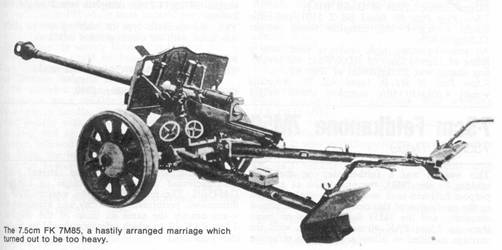
Photo from Ian Hogg’s book
of the 7M85 field gun showing the leFH 18 howitzer shield, the large
leFH 18-type wheels and the Pak 40 trails, breech, gun barrel and
muzzle brake. Below the gun sight are the elevation and traverse handwheels.
The larger wheels would help with allowing greater elevation. This
is the only definite photo of this gun I know of.
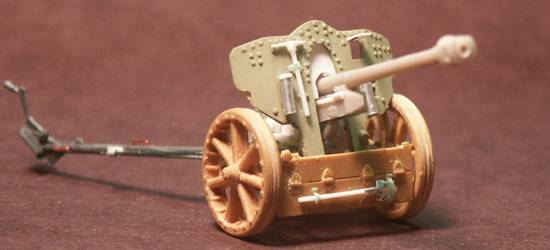
This series of photos shows my
interpretation of the FK 7M85 prior to painting. My choice in the
parts used should not be taken as an endorsement. The trails are from
an ESCI Pak 40, the wheels & shields are from LEVA Productions
(I could not find wheels to match those in the historical photo above).
The gun cradle, shovel, pick and storage tubes on the shield and the
center sliding shield are scratchbuilt. Grooves were carefully sawed
into the solid rubber tire; a difficult task to do well.
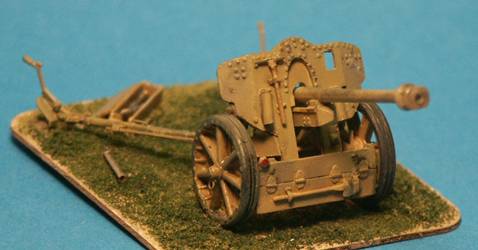
The same view of the gun painted
in a plain Dunkelgelb scheme. The tool handles have been painted wood
though they were likely painted the same color as the gun, just like
on US vehicles. (Editor’s note: I’ve read German tool
handles were left in their natural color.) The tail light is painted
red but I know not if this is correct. Pak 40 ammunition is at the
left corner.
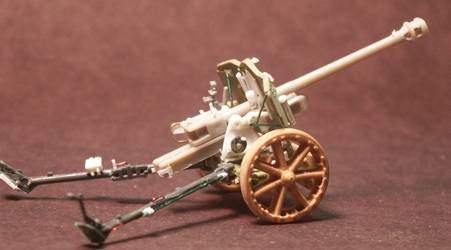
The right side of the model showing
the Roden gun, cradle and recoil system from their Pak 40 model. Grab
handles and shield braces are replicated with copper wire. A scratchbuilt
elevation handwheel is visible on the cradle.
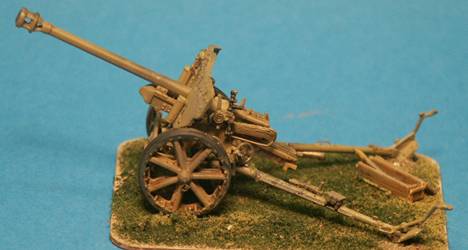
Left side of the completed gun on a base made of a Formica counter-top
sample covered with model railroad flocking. The ammunition box is
scratchbuilt.
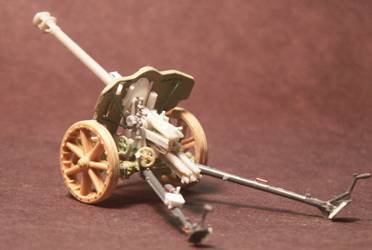
The left rear of the 7M85
showing the leFH 18 handwheels from the LEVA kit. A dial artillery
gun sight visible on the left side of the cradle is stolen from Revell’s
soft plastic leFH 18 howitzer kit. A scratchbuilt small box is added
to the left trail based on my photos of the cannon. A scratchbuilt
recoil shield is on the left side below the gunsight.
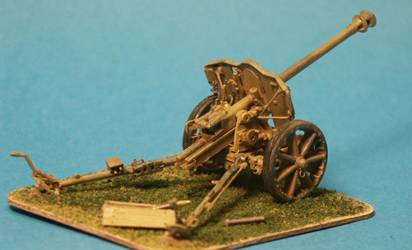
Right-rear view of the 7M85 Feld Kanone.
Comparing this with the photo of the actual gun below I see I have
the right handwheel wrong, basically because a spoked handwheel was
unavailable.
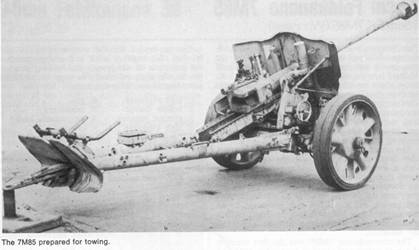
A second photo from Ian Hogg’s
book of the right rear side of the 7M85 field gun in the travel mode.
Notice that there appears to be an elevation handwheel on the right
side of the gun carriage in addition to the two handwheels on the
left side.
The 7.5-cm Feld Kanone 7M59.
Hogg includes no photo of a FK 7M59 in his book. The closest thing
I have found is a gun identified as a Pak 40 at the German Panzermodellbau
website. This gun appears to be a Pak 40 modified to have greater
elevation, like the 7M59. I decided to use this gun as the basis for
my 7M59 conversion and this weapon is fitted with eight-spoked wheels.
Unfortunately ESCI and Matchbox gives us only six-spoked wheels. The
Roden Pak 40 1/72 scale wheels are smaller than the ESCI wheels, being
closer to the size of the 1/76 Fujimi and Matchbox wheels. When I
built these models, the very nice Dragon Model’s 1/72-scale
Pak 40 kit had not yet been released.
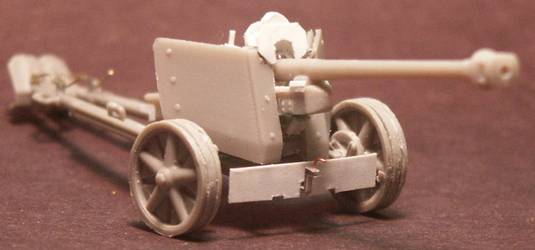
Above is my interpretation
of the 7M59 with an octagonal fillet extension to the shield above
the gun barrel, allowing a higher elevation. The Pak 40 has a double
shield of 5mm thick plates. This fillet is added to both the inner
and outer shield of the FK 7M59, was riveted or bolted on, and had
a sliding center shield that went up and down with the gun barrel.
The lower part of the shield has been deleted and a towing hitch added,
perhaps for an ammunition trailer.
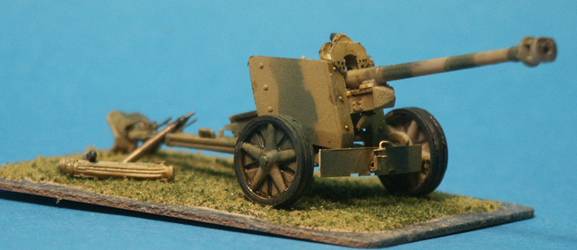
Above is the same view of the
completed 1/72-scale model 7M59 completed in a two-tone scheme of
Dunkelgelb and Olivgrun. Next to the gun are some resin 7.5-cm Pak
40 rounds and ammunition tubes from Attack.
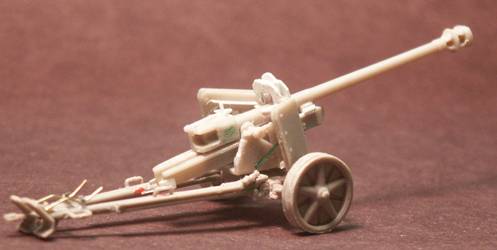
The model FK 7M59 was built
almost completely as an out-of-the box Roden Pak 40, other than the
elevation extension for the shield, the gun shield brace and the trailer
hitch, the trail’s handles and shield supports which were replaced
by wire. The grab handles on the trails are a tad thick and would
look better replaced by brass wire. Most of the detailing of this
obscure weapon can be done with our references for the Pak 40.
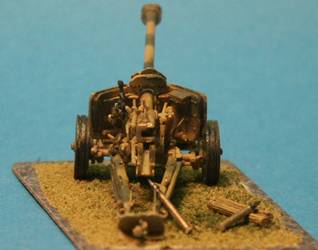
Being based on an anti-tank
gun where the gunner had full control of the elevation and traverse,
note that on the right side of the carriage there is no elevation
wheel as on the FK 7M85.
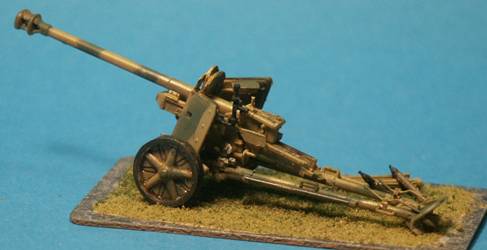
Left side of my finished
7M59 Feld Kanone. Since the gun was used as a field gun as well as
an AT gun I gave the weapon a gunsight similar to that on the leFH
18 howitzer.
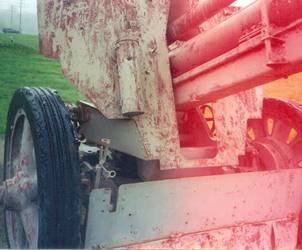 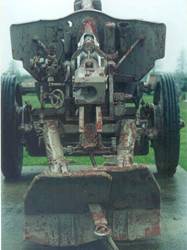
These are two photos of a
10-cm le FH 18/40 on display at Aberdeen Proving Ground, Maryland,
USA. This set will be helpful in detailing the FK 7M85, which has
the same carriage, trails, wheels and shield. Replace the 10.5-cm
howitzer with the 7.5-cm Pak 40 kanone. In the right-hand photo notice
the traverse handwheel on the left and the elevation handwheel to
the right of the breech.
REFERENCES
GERMAN ARTILLERY of World War Two, Ian V. Hogg,
Stackpole Books, and Greenhill Books, (1997). A superb hardcover book
with photos and brief history of the 7M85 and 7M59.
http://www.panzer-modell.de/
Within the Reference, In Detail section of this website is a series
of photos of what is identified as a Pak 40 though that may be a rare
FK 7M59 gun. Note that its shield has been modified to allow a greater
elevation, and there is a trailer hitch under the shield; unlike any
other Pak 40 I have seen. This could instead be a post war modification.
|






